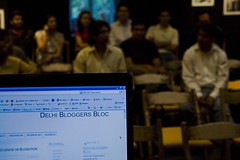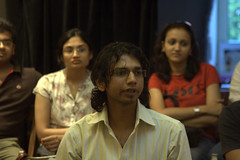Delhi Bloggers blaze a trend 6
This article of mine got published in HT. I am posting it here as well.. That piece also carried Rajesh Lalwani’s post on microblogging.
Internet and blogging have both come a long way. In the days of yore, we used to have Web pages on Angelfire or Geocities. There was a trend of putting freely available javascript code on the “homepages” to add the bells and whistles. An occasional addition to the “guest count” was a luxury. Interaction with the “guests” was out of the question.
Cut to now. The homepage has been replaced by the blog. Unlike traditional writing, blogging is not just meant for reading or consuming, it also initiates interaction and creates conversation. Bloggers build upon the thoughts and ideas of other bloggers and they all engage in the conversation. The blog has gone from being just an ‘online diary’ to a tool of professional and personal growth. If you are a blogger, anything, including but not limited to, book deals, job offers, celeb status, help in remote corners of the planet, TV interviews, regular income and career changes can come your way. But blogging is not only about reclusive online expression or anonymity. With online interaction comes the need to meaningfully interact offline as well, which in turn enriches online interaction. Blog communities and meetings address that need – and do much more. Not only are such communities, a great way to network socially and professionally, they also introduce bloggers to like-minded people who share the same tastes and a diverse variety of interesting opinions. A bloggers meeting fits the bill for social networking and may also align itself to activities in line with a group’s interests. Meeting offline is now the most natural thing to do once you have interacted online. That could get you a venture partner, a job offer, new contacts – or love!
Delhi’s bloggers happen to have a strong community. The group called the Delhi Bloggers Bloc (www.delhibloggersbloc.com) also happens to be possibly the oldest such community in India. It provides bloggers a common platform to interact online as well as offline apart from giving them a chance to share and promote their blogs. Frequent activities like photography/heritage walks, fun gatherings in pubs/cafes and serious meetings with agendas and outreach exercises, make sure that there is something in it for everyone. In fact so inspired was Sanjukta Basu, a veteran member of DBB, that she initiated another community on the same lines when she shifted to Bangalore. The Delhi bloggers community (DBB) was formed after some bloggers met at their first ever Delhi Blogger’s Meet on 13th January, 2004. The members recently celebrated the group’s 4th anniversary as well with a successful meeting. The group aspires to seek new and worthwhile ways to interact, learn, share, discuss and evolve both online and offline. The best part of this group is having so many people from diverse backgrounds, who one may not come across in the “normal” social circles one has. The group consists of an eclectic mix of people ranging from 14 to about 50 years of age with IT professionals, architects, chartered accountants, lawyers, doctors, journalists, social activists, housewives, army officers, media professionals, students, photographers, professional bloggers and others as members.
To be a member of the group, you can be a blogger who is or has been in Delhi or you can be a blog reader or someone who is keen on blogging and needs assistance in starting one. There is no age limit for joining. However if you are still studying, make sure your parents do not have a problem in your indulging in online activities. The group has had 23 officially chronicled meetings, a couple of unofficial meets, lots of history walks, sharing of photography tips, book reading sessions—and even kite flying days! The group, while being in the process of educatinonal exercises on blogging, has undertaken initiatives with voluntary groups and schools to help them harness the power of blogging. With so many forms of online interactions available, the group has its presence on social networking sites like Facebook and Orkut as well.
To encourage professional networking amongst the DBB members, the group has a presence in business networking sites like LinkedIn. It also has a presence on flickr.com, the photo sharing site where they can share pictures from their blogger meetings as well as individual pictures.
There is a strong presence of photographers and photo bloggers in the group. With the advent of new media, the group has already had Delhi’s first Twitter meetup, for those who do mini-diaries on the go through Twitter.com It exists on Twitter as delhitweetup. The nerve centre of its interaction is however, a mailing list on Yahoogroups (http://groups.yahoo.com/group/delhibloggers/). All that is not easy for those who have other things to do. Many active members have taken time off their workaday lives to make a community and sub-culture out of blogging.
(The author is a software professional, photographer and founder of Delhi Bloggers Bloc.)


 and finally got in touch with some nurseries. The people there confirmed that free saplings are indeed distributed (which is so unbelievable because this is something that’s very likely to be exploited big time). But they were going to distribute the saplings only from June onwards. This weekend I went to one of the nurseries and got myself 11 saplings. I was quite embarrassed to ask them for such a big number (lest they thought I was going to sell them) but my thoughts were put at rest when I saw a couple, stuffing sacks with saplings. I later learnt that they had taken 60 saplings with them. Various plants like the saplings of Neem, Jamun, Mango, Peach, Gulmohar, Kanner, Peepal, Alstonia, Kachnar, Arjun, Bombax, Papri, Philkan, Jungle Jalebi, Sheesham, Amaltas, Rose, Bougainvillea etc., are available with them.
and finally got in touch with some nurseries. The people there confirmed that free saplings are indeed distributed (which is so unbelievable because this is something that’s very likely to be exploited big time). But they were going to distribute the saplings only from June onwards. This weekend I went to one of the nurseries and got myself 11 saplings. I was quite embarrassed to ask them for such a big number (lest they thought I was going to sell them) but my thoughts were put at rest when I saw a couple, stuffing sacks with saplings. I later learnt that they had taken 60 saplings with them. Various plants like the saplings of Neem, Jamun, Mango, Peach, Gulmohar, Kanner, Peepal, Alstonia, Kachnar, Arjun, Bombax, Papri, Philkan, Jungle Jalebi, Sheesham, Amaltas, Rose, Bougainvillea etc., are available with them.



